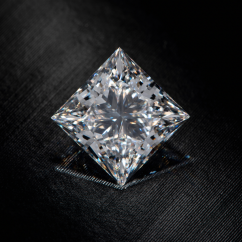Articles and News
GIA Examines Record-Setting 16-Carat Lab-Grown Diamond February 01, 2022 (0 comments)

Carlsbad, CA—Scientists at GIA (Gemological Institute of America) recently examined a 16.41 princess-cut lab-grown diamond, the largest known diamond produced by the chemical vapor deposition (CVD) method. Image: The new record size for CVD laboratory-grown diamond—16.41 ct, with G color and VVS2 clarity—has been achieved by Shanghai Zhengshi Technology Co. Ltd. This is an as-grown diamond; no post-growth treatment was applied for color improvement, either before or after faceting. Photo by Towfiq Ahmed.
The stone, from the Shanghai Zhengshi Technology Co. Ltd., was determined to be a G color, VVS2 clarity, with the observable characteristics of a CVD-grown diamond. Detailed spectroscopic readings confirmed there was no post-growth treatment to improve either the color or the clarity of the diamond.
“The first CVD diamond I examined in 2003 was a 0.23-ct. pear shape, with clear brown color,” said Dr. Wuyi Wang, GIA vice president of research and development, who examined the new record-sized CVD diamond. “This 16.41-ct. laboratory-grown diamond demonstrates the advances in CVD growth technology. This achievement has important implications for the many scientific and industrial applications for high-quality laboratory-grown diamonds.”
“GIA has examined thousands of laboratory-grown diamonds since the first gemological description of them by Robert Crowningshield in 1971,” said Tom Moses, GIA executive vice president and chief laboratory and research officer. “In the decades since, we have shared the results of our detailed research; this is an important aspect of our consumer protection mission.”
After the scientists’ examination, GIA experts graded the diamond using the Institute’s standard rigorous process for laboratory-grown diamonds, issuing GIA Laboratory-Grown Diamond Report number 2225246686.
A brief report authored by Wang and GIA research associates Stephanie Persaud and Elina Myagkaya is available on the Institute’s website, GIA.edu. It will be published in a subsequent edition of GIA’s quarterly journal, Gems & Gemology.







